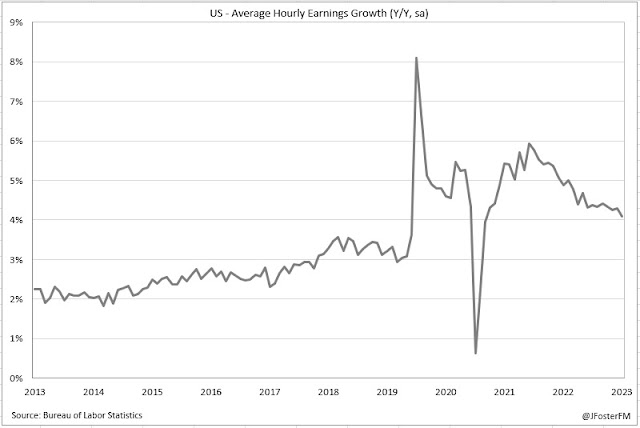Sentiment in markets turned positive this week amid indications hiking cycles across the major economies have peaked, putting rate cuts back on the radar in 2024. A cooling in the US labour market accelerated declines in Treasury yields, notably the 10-year benchmark (4.57%) is now well off the recent highs around 5%. In response, US equities rallied to their strongest weekly gains in 12 months, providing the backdrop for the Australian dollar to rise sharply. Earlier in the week, the Bank of Japan made tweaks to yield curve control, now referring to 1% as a 'reference rate' for 10-year bonds rather than a hard cap.
The Fed maintained a steady hand this week, leaving rates in the 5.25-5.5% range as Chair Jerome Powell said the FOMC would proceed carefully. Chair Powell said the decision reflected the key judgments that monetary policy was already at a restrictive setting for growth and inflation and that the full effects from its earlier rate hikes remained in the pipeline. Referencing the acceleration in US GDP in Q3, the FOMC's assessment of economic growth was upgraded from ''solid" to "strong"; however, Chair Powell noted that inflation had continued to decline and that supply-demand imbalances in the labour market had eased. Speaking to this, October's nonfarm payrolls data came in soft relative to expectations. Employment slowed to a 150k rise (vs 180k exp) and downward revisions cut 101k from payrolls over August and September. The unemployment rate ticked up to 3.9% from 3.8% - and the underemployment rate lifted from 7% to 7.2% - as the participation rate softened by 0.1ppt to 62.7%. Summarising the cooling in conditions, average hourly earnings growth slowed from 4.3% to 4.1%yr, its slowest since June 2021.
Markets lean towards the RBA hiking rates at next week's meeting, an outcome that would end a 4-meeting stretch of unchanged rates in Australia. Data through the week was generally viewed as reinforcing this expectation. Retail sales posted a 0.9% rise in September - its strongest rise since January - with discretionary categories a key contributor (see here). Quarterly sales lifted by 0.8%, but that reflected only a marginal increase in underlying volumes (0.2%) that was underpinned by rapid population growth.
This also remains a key factor in the housing market, with housing prices rising a further 0.9% nationwide in October, to now be almost 8% above the January low, as strong demand continues to run up against tight supply, particularly in the capital cities. Although there is a sizeable pipeline of houses under construction, dwelling approvals were sitting near decade lows in September (see here). Strength on the demand side was reflected in another rise in housing finance commitments (0.6%), now up 9.5% on the cycle low in February (see here). In other news, Australia's trade surplus contracted sharply to $6.8bn in September, driven by an acceleration in import orders (see here).
In the UK, the Bank of England kept rates at 5.25% in a 6-3 decision by the MPC. Although the MPC is not ruling out further hikes, it communicated that it was now in a holding pattern with the statement noting that: "Monetary policy will need to be sufficiently restrictive for sufficiently long to return inflation to the 2% target...". Over recent months, market pricing for the peak BoE rate has declined materially and the curve now implies that the next move from the MPC is expected to be a rate cut early in the second half of next year. This was something Governor Andrew Bailey and other officials pushed back against at the post-meeting press conference.
However, given the weak outlook published in the November Monetary Policy Report, a case could be made for a lower bank rate down the line. The UK growth outlook was cut to 0.6% this year (from 0.9%), 0% in 2024 (from 0.1%) and 0.4% in 2025 (from 0.5%), resulting in a higher path for the unemployment rate to 5% (from 4.8%) over the next couple of years. Governor Bailey, however, said that there remained upside risks to the inflation outlook - including from energy and services prices - that it needed to guard against. Factoring in these risks, as well as the lower pricing for the peak BoE rate, the 'mean' forecast is for inflation to still be slightly above target in late 2025 (2.2%), which is clearly keeping the MPC cautious.
Euro area inflation declined substantially from 4.3% to 2.9%yr in October - a 27-month low - to be well down from the 10.6% peak 12 months ago. While this includes a sizeable base effect as a surge in energy prices fell out of the 12-month calculation, the core rate also declined to a 15-month low, from 4.5% to 4.2%, indicating the broader inflationary pulse is easing. And a weak outturn of -0.1% for Q3 GDP points to this continuing. However, the ECB's Isabel Schnabel said in a speech this week that the easy-won gains in lowering inflation had already been achieved and that the 'last mile' in returning to 2% inflation would likely be difficult. This is consistent with the Governing Council's higher-for-longer messaging on rates at last week's meeting.




